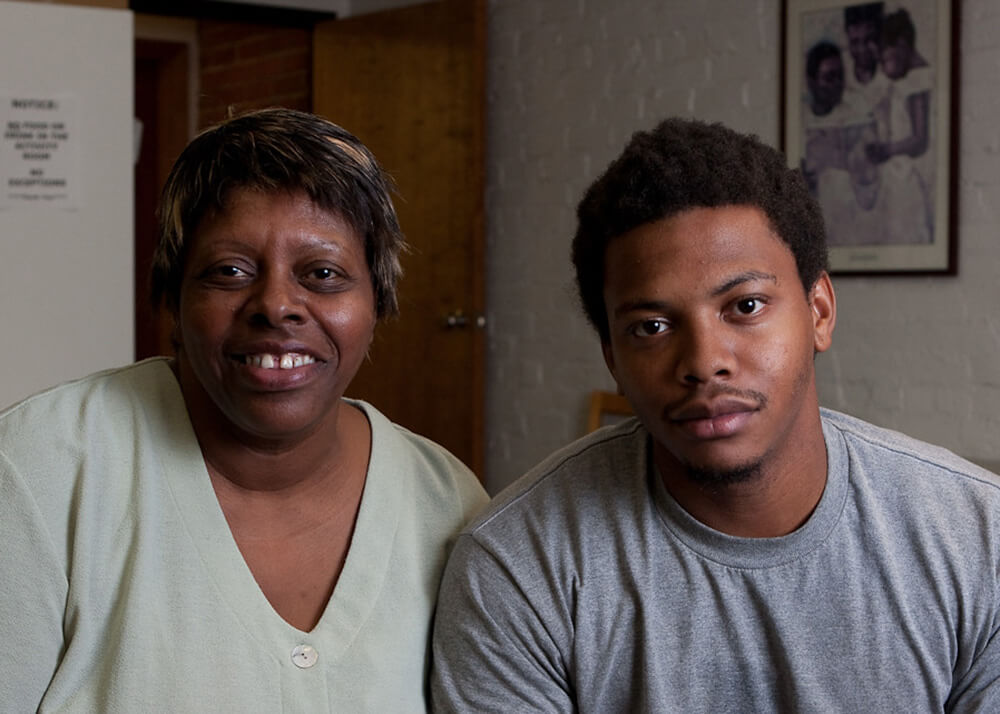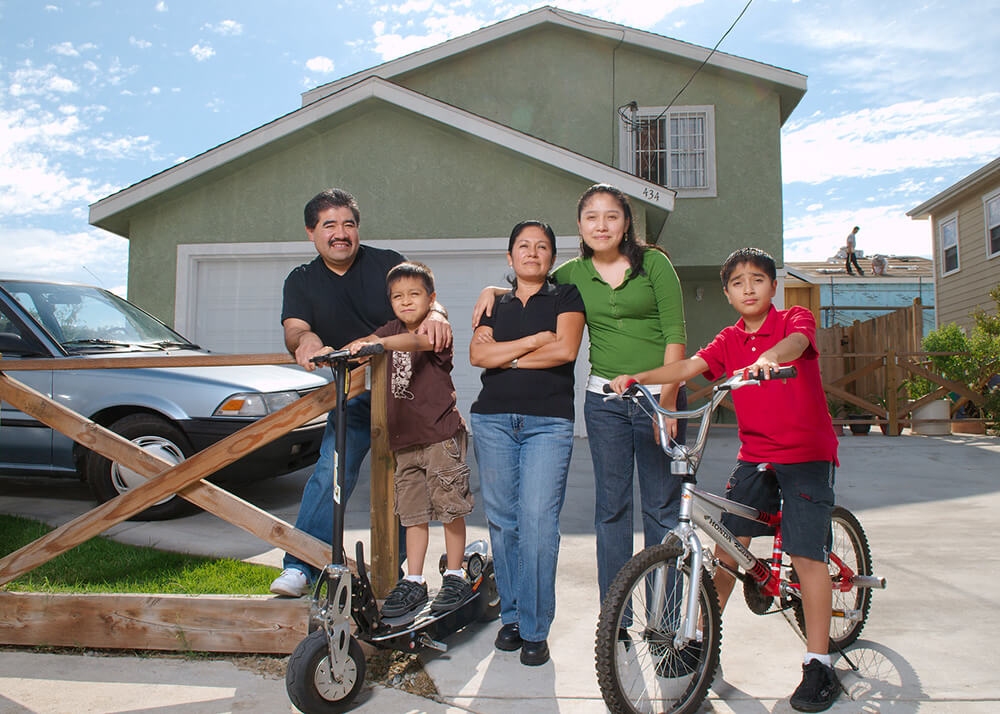CAUSES
Housing insecurity and homelessness are caused by a combination of economic and structural factors.

Some of the most significant causes of housing insecurity and homelessness include:
- Vastly underfunded affordable housing and homelessness programs;
- Land use and zoning policies that exclude affordable housing and create racial, economic, and housing segregation;
- High costs of living, inadequate wages, and wealth and income inequality;
- A safety net that does not provide sufficient housing or supportive services.
Other structural causes include policies, programs, and systems that have failed to promote equity and routinely discharge people into homelessness, such as:
- A structurally-racist justice system, which disproportionately arrests and incarcerates people of color, severely reduces employment opportunities, and strips individuals and communities of wealth;
- An overcrowded foster care system, which often discharges youth into adulthood with few resources to support this transition. Research has found that 31-46% of former foster youth have experienced homelessness by age 26;
- An education system that reinforces racial, economic, and housing segregation; and
- Lack of accessible, high-quality, and affordable health care, including mental health and substance use treatment.
Housing California advances evidence-based solutions that address the underlying causes of housing insecurity and homelessness. Click here to learn more.

Some of the most significant causes of housing insecurity and homelessness include:
- Vastly underfunded affordable housing and homelessness programs;
- Land use and zoning policies that exclude affordable housing and create racial, economic, and housing segregation;
- High costs of living, inadequate wages, and wealth and income inequality;
- A safety net that does not provide sufficient housing or supportive services.
Other structural causes include policies, programs, and systems that have failed to promote equity and routinely discharge people into homelessness, such as:
- A structurally-racist justice system, which disproportionately arrests and incarcerates people of color, severely reduces employment opportunities, and strips individuals and communities of wealth;
- An overcrowded foster care system, which often discharges youth into adulthood with few resources to support this transition. Research has found that 31-46% of former foster youth have experienced homelessness by age 26;
- An education system that reinforces racial, economic, and housing segregation; and
- Lack of accessible, high-quality, and affordable health care, including mental health and substance use treatment.
Housing California advances evidence-based solutions that address the underlying causes of housing insecurity and homelessness. Click here to learn more.
Causes — Digging Deeper
Lack of Affordable Housing
California is facing a shortage of nearly 1 million units affordable to extremely low-income (ELI) renters alone, without accounting for the shortage faced by very low-income (VLI) and low-income (LI) renters. This scarcity of affordable housing is due to a combination of restrictive and exclusionary land use and planning policies, a lack of federal and state investment in affordable housing, and local opposition to the development of affordable housing.
In addition to the shortage of existing affordable units, the production of new affordable housing is not keeping pace with increasing demand. In the 2018 Challenges and Opportunities assessment, the California Department of Housing and Community Development reported that in the last Regional Housing Needs Allocation (RHNA) cycle, “not one region built enough housing to meet its regional need.” New home production fell short for all income levels, but was lowest for deed-restricted homes that serve lower-income households.
While the availability of affordable homes in California has decreased, the cost of private-market housing has soared in recent decades, and wages for low income households have not kept up. This increase in income inequality and the cost of living is another contributing factor to housing insecurity and homelessness. According to the National Low Income Housing Coalition (NLIHC), 76% of all extremely low-income households in California are severely cost-burdened, paying more than half their income on rent. In 2018, more than half of California renters struggled to pay high housing costs.
With such a huge lack of affordable homes, increasing costs on the private market, and stagnant incomes, many households are forced to pay more for housing than they can afford, to move to lower-cost areas and often commute to work for hours each day, squeeze into overcrowded housing to afford rent, or live in unsafe and unsanitary conditions, and in the most dire situations, fall into homelessness.
A Reactionary, Fragmented, Underfunded Approach
California and the federal government have not responded to homelessness with a comprehensive set of policies and investments sufficient to ensure that every person has a safe, affordable home.
Federal disinvestment beginning in the 1980s placed homeownership and affordable rents out of reach for low- and moderate-income households. The Department of Housing and Urban Development (HUD), the federal agency that provides housing for low-income households, experienced several decades of program underfunding, beginning with former President Reagan and continuing through the Trump Administration. During this period, the federal government stopped adequately funding new construction and limited subsidized rents for low-income units. Furthermore, the federal government has shifted from directly subsidizing affordable housing to leveraging tax credits to incentivize private industry into developing a limited stock of affordable housing.
California’s system of addressing homelessness is fragmented, and nowhere is this more evident than in the administration of State programs and resources. According to the 2020-2021 state auditor’s report there are currently 9 state agencies that oversee 41 programs whose funding provides services to people experiencing homelessness.
Responsibility for ensuring that everyone has a safe, affordable home has been divided between state, local, and federal governments. In 2020, 580,000 people experienced homelessness in the United States, with over 161,548 Californias experiencing homelessness (Point in Time Count).
Local, state, and federal governments must step up and implement bold, strategic and evidence-based solutions to ensure healthy, affordable homes for everyone.
Exclusionary Zoning Restriction
Cities, counties, and other localities impose zoning ordinances to regulate how their land is used, often citing an interest in protecting the public’s health, safety, and general welfare. The first American zoning ordinance dates to 1885, when Modesto, CA, sought to limit the location of bathhouses. Zoning codes proliferated throughout the early part of the twentieth century, and by 1926 were recognized by the Supreme Court as a legitimate use of a local government’s authority.
Zoning ordinances are also products of their time. During the same forty-year period, zoning laws were used to explicitly segregate Black communities from white ones. Blacks-only neighborhoods were often relegated to areas near polluted land and without amenities. Some ordinances allowed white landlords to evict black tenants, while others prohibited Black families from buying homes in white neighborhoods. Although the Fair Housing Act of 1968 has outlawed racial zoning, the practice has created patterns of residential segregation that persist throughout the country. Economic inequality reinforces this legacy of systematic exclusion and complicates identifying durable solutions.
Zoning ordinances continue to be important tools for localities to manage how they develop, allowing them to plan for needs like retail space, employment centers, parks and open space, and housing. Yet they can uphold patterns of residential segregation, be overly restrictive, and too often be weaponized to prevent architecturally and culturally sensitive housing from being developed.
Anti-growth movements, for example, have leveraged land use regulations like zoning ordinances and the California Environmental Quality Act (CEQA) to preclude affordable housing development in predominantly-white neighborhoods under the guise of protecting environmentally sensitive areas and preserving the original character of neighborhoods. According to the Terner Center for Housing Innovation, California zones a quarter of the land in the state’s municipalities for multifamily housing, while more than half is set aside for single-family, detached homes. Because most affordable housing is multi-family development, zoning restrictions based on building size and density serve as a de facto prohibition on building affordable housing in many neighborhoods throughout California, particularly whiter and wealthier neighborhoods.
California’s zoning laws must adapt to allow for more housing types, particularly multi-family affordable housing, if it is to solve its housing affordability crisis.
Wealth & Income Inequality
Today, most people become homeless because they do not make enough money to pay for housing. The inability to afford housing is caused by stagnant wages, benefits, and other issues impacting one’s ability to work, such as a medical condition, limited education, a gap in work history, or justice system involvement. These barriers are further exacerbated by a lack of affordable housing. Middle- and low-income households have increasingly struggled to afford a roof over their heads as families experience growing income inequality. According to the National Low Income Housing Coalition’s Out of Reach report, at the California minimum wage of $14 per hour, an individual must work 89 hours a week in order to afford a modest 1-bedroom rental at the fair market rate. Simply put, too many people do not make enough money to afford housing, and there are not enough affordable housing options or rental subsidies to serve all who need them.
Wealth and income inequality is further exacerbated by the structural racism that underlies a combination of public and private institutions and systems, where black communities are neglected and/or actively harmed. The Black-White Wealth Gap, a report from The Brookings Institution, found that the average net worth of black households in 2016 was $17,150, versus the average white household wealth of $171,000. This racial wealth gap exists due to a series of oppressive policies and systems. Because many Black households have been unable to build wealth over time, they don’t have the safety net or financial cushion needed to survive a financial hardship such a job loss or large unexpected expenses, and are often deterred from taking greater risks, such as starting a business, becoming an investor, taking on debt, or going to college. If a household doesn’t have the emergency savings and wealth to weather a temporary setback like losing a job, natural disaster, or a health emergency, they can easily end up falling into homelessness.
Ending the housing and homelessness crisis will take ALL of Us
Ending housing insecurity and homelessness must begin by understanding that this is a humanitarian issue rooted in systems that affect our housing, income, health, and various critical aspects of our lives. We must regularly examine and evaluate how well these systems are working, especially for Californians struggling the most. People and their well-being must remain central in the development of these systems so everyone has an opportunity to thrive.
Unfortunately, some opinion leaders aim to divert attention from systems to people experiencing homelessness. Rather than focusing on bold legislation that can mitigate the actual causes, their narratives highlight the results of homelessness like encampments and lay blame on individuals who are often casualties of a broken system. We must marshal public and political will through unrelenting policy advocacy that focuses on the real issues and evidence-based solutions.
Ending the housing and homelessness crisis will take ALL of Us
Ending housing insecurity and homelessness must begin by understanding that this is a humanitarian issue rooted in systems that affect our housing, income, health, and various critical aspects of our lives. We must regularly examine and evaluate how well these systems are working, especially for Californians struggling the most. People and their well-being must remain central in the development of these systems so everyone has an opportunity to thrive.
Unfortunately, some opinion leaders aim to divert attention from systems to people experiencing homelessness. Rather than focusing on bold legislation that can mitigate the actual causes, their narratives highlight the results of homelessness like encampments and lay blame on individuals who are often casualties of a broken system. We must marshal public and political will through unrelenting policy advocacy that focuses on the real issues and evidence-based solutions.

The discussions around the causes of housing insecurity and homelessness must be centered on the systems, policies, and a history of racism that have led to economic instability and out-of-reach housing. Housing California’s Roadmap 2030 provides a comprehensive, equity-centered framework for structural changes that includes over 50 evidence-based policy solutions to address these complex issues.
In a state known for progressive politics and forward thinking, we must work together to live up to our values, enabling all Californians to have a safe, decent place to call home.
The discussions around the causes of housing insecurity and homelessness must be centered on the systems, policies, and a history of racism that have led to economic instability and out-of-reach housing. Housing California’s Roadmap 2030 provides a comprehensive, equity-centered framework for structural changes that includes over 50 evidence-based policy solutions to address these complex issues.
In a state known for progressive politics and forward thinking, we must work together to live up to our values, enabling all Californians to have a safe, decent place to call home.

Learn about Housing California’s legislative policy priorities, the Roadmap Home initiative, and ways you can take action to tackle homelessness and housing insecurity in our state today.
